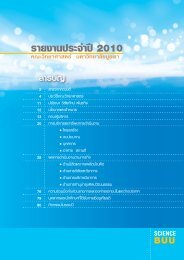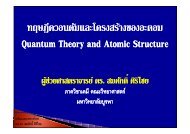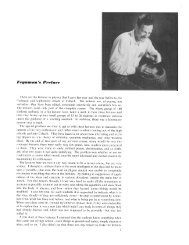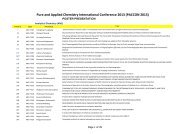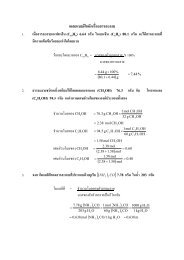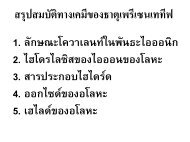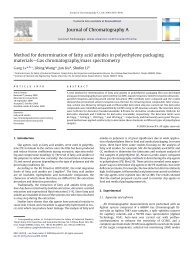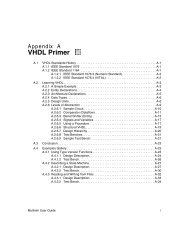USER MANUAL SWAN Cycle III version 40.72A
USER MANUAL SWAN Cycle III version 40.72A
USER MANUAL SWAN Cycle III version 40.72A
Create successful ePaper yourself
Turn your PDF publications into a flip-book with our unique Google optimized e-Paper software.
14 Chapter 2<br />
• each wet computational grid point that is linked to only one other wet computational<br />
grid point, is removed and<br />
• each wet computational grid point that has no wet links is removed.<br />
The effect of this filter is that if exception values are used for the depth grid or the<br />
curvi-linear computational grid, one-dimensional water features are ignored in the <strong>SWAN</strong><br />
computations (results at these locations with a width of about one grid step may be<br />
unrealistic). If no exception values are used, the above described filter will not be applied.<br />
As a consequence, one-dimensional features may appear or disappear due to changing<br />
water levels (flooding may create them, drying may reduce two-dimensional features to<br />
one-dimensional features).<br />
The computational time window must be defined by the user in case of nonstationary<br />
runs. The computational window in time must start at a time that is early enough that<br />
the initial state of <strong>SWAN</strong> has propagated through the computational area before reliable<br />
output of <strong>SWAN</strong> is expected. Before this time the output may not be reliable since usually<br />
the initial state is not known and only either no waves or some very young sea state is<br />
assumed for the initial state. This is very often erroneous and this erroneous initial state<br />
is propagated into the computational area.<br />
The computational time step must be given by the user in case of nonstationary runs. Since,<br />
<strong>SWAN</strong> is based on implicit numerical schemes, it is not limited by the Courant stability<br />
criterion (which couples time and space steps). In this sense, the time step in <strong>SWAN</strong> is<br />
not restricted. However, the accuracy of the results of <strong>SWAN</strong> are obviously affected by<br />
the time step. Generally, the time step in <strong>SWAN</strong> should be small enough to resolve the<br />
time variations of computed wave field itself. Usually, it is enough to consider the time<br />
variations of the driving fields (wind, currents, water depth, wave boundary conditions).<br />
But be careful: relatively(!) small time variations in depth (e.g. by tide) can result in<br />
relatively(!) large variations in the wave field.<br />
As default, the first guess conditions of a stationary run of <strong>SWAN</strong> are determined with the<br />
2 nd generation mode of <strong>SWAN</strong>. The initial condition of a nonstationary run of <strong>SWAN</strong> is<br />
by default a JONSWAP spectrum with a cos 2 (θ) directional distribution centred around<br />
the local wind direction.<br />
A quasi-stationary approach can be employed with stationary <strong>SWAN</strong> computations in a<br />
time-varying sequence of stationary conditions.<br />
The computational spectral grid needs to be provided by the user. In frequency space,<br />
it is simply defined by a minimum and a maximum frequency and the frequency resolution<br />
which is proportional to the frequency itself (i.e. logarithmic, e.g., ∆f = 0.1 f). The<br />
frequency domain may be specified as follows (see command CGRID):<br />
• The lowest frequency, the highest frequency and the number of frequencies can be<br />
chosen.





